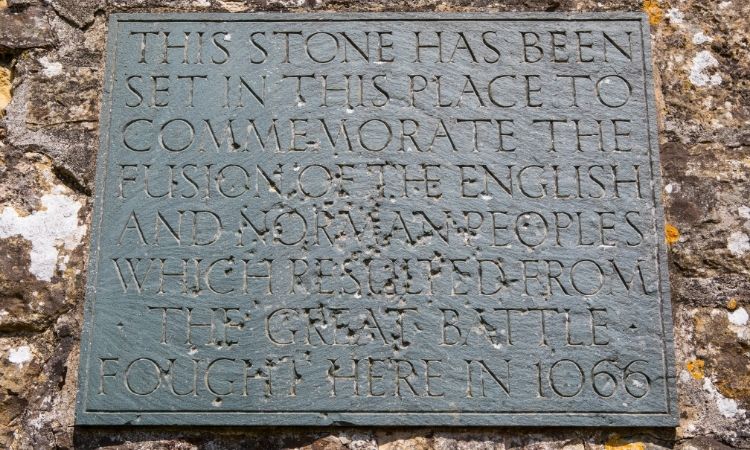To build your own Itinerary, click  to add an item to your Itinerary basket.
to add an item to your Itinerary basket.
Already saved an Itinerary?



You are here: UK History > Royal History > House of Normandy > William I | the conquering king
After exploring England’s early monarchs, the Saxon kings, from Egbert through to Edward, we are now onto England’s first Norman king and one of the most influential early monarchs, William I, aka William the Conqueror.
Born: 1028 at Falaise, Duchy of Normandy
Died: 9th September 1087 (aged 59), at Priory of Saint Gervase, Roeun, Normandy
Reign: 25th December 1066 – 9th September 1087
Parents: Robert the Magnificent of Normandy and Herleva of Falaise
Predecessor: Harold Godwinson
Successor: William II (son)
Spouse: Matilda of Flanders
Children: Richard II (Duke of Normandy), Richard, Adeliza, Cecilia, William II (King of England), Constance (Duchess of Brittany), Adela (Countess of Blois), Henry I (King of England)
Royal House: Normandy – claim via his relative, King Edward.
Following the death of Edward, who was unmarried and heirless, Harold Goodwin, was nominated to the role of ruler by a team of nobles, becoming Harold II. The fact that he was nominated didn’t mean that his reign was safe however, as William, the Duke of Normandy, also had a claim – he was Edward's second cousin and claimed that he had been promised the throne in the event of Edward’s death. So, the fact that Harold was named king instead, upset him a little. He decided to raise an army to claim his inheritance and invade England. He landed on England's south east coast, hence, the famous battle taking place in Hastings. But before he became William the Conqueror, one of England’s most influential monarchs, who was he?
Historians are unsure of William’s exact date of birth, but they believe it to be around 1028. Though he was born into the nobility (his father was Duke Robert I of Normandy - known as Robert the Magnificent, which is quite the title), he was actually illegitimate. Luckily for him, both Robert the Magnificent and the other Norman nobles recognised him and after Robert's death, William inherited his land and titles. However, being both young (it was thought that he was around 8 years old at the time) and illegitimate, meant his hold on the dukedom was a difficult one. His early reign mostly saw him trying to keep control of Normandy, with many of the nobles battling each other and manipulating him for their own ends.
Once he reached his majority, William was keen to secure his crown and managed to quash some of the more rebellious members of his court by marrying Matilda of Flanders. She was the granddaughter of the French King, Robert II, and initially, she turned him down - the story goes that he tackled her from her horse to show his displeasure. Sadly for Matilda, love and actually wanting to get married weren't particularly important, especially if you were a woman. However she felt about him, they did tie the knot and had ten children together.
Once he secured Matilda and legitimised his hold on Normandy, William was keen to start expanding his horizons. One kingdom that caught his eye was that of England, which, on the death of his cousin, Edward, found itself without a leader. Though Harold II had been named King of England by the nobles, he wasn't actually a blood relative of the previous monarch and there were a number of other claimants. William and his brother were two such claimants, with William adament that Edward and promised him the English throne in the event of his death. William bided his time, assembling an army and waiting for the right moment to invade. He finally set off while Harold was busy with fighting his own brother. Harold did get wind of the invasion though and sent those he could spare to the coast. William eventually arrived in England in the autumn of 1066.

Image: Stone commemoration of the Battle of Hastings
The Battle of Hastings is perhaps one of the most famous battles to take place on British soil. Hastings, located in Sussex, has several points of interest relating to the battle, including an area of the town which is literally called Battle – it is where it is thought the actual fighting took place. The battle began at around 9am on 14th October and it is recorded that both sides decided to stop for lunch during the fighting, little is known about the timeline and events of the battle, but it is agreed that it ended with the death of Harold, though whether that was by William’s hand is debated.
The Bayeux Tapestry claims that Harold was killed with an arrow to the eye, but differing stories were told. He was identified the day after the battle and what became of him is unclear. Historians say that William ordered that the body be thrown in the sea, we do know that many of Harold's army were left on the battlefield where they were slain, even those who were important nobles. Others claim that Harold’s body was secretly recovered and buried at Waltham Abbey, which he founded.
Though William had a decisive win at Hastings, he didn’t automatically become the King, there was a little resistance from the clergy and others who nominated an alternative king. However, after securing Dover, Canterbury and Winchester, William marched on London and began constructing a castle. Any resistance was stamped out during this time, and he was eventually crowned at Westminster Abbey on Christmas Day 1066.
As part of his plan to secure England, one of the first acts William undertook as king was the ordering of castles, keeps and mottes to be built, including the Tower of London’s White Tower. He is also credited with Warwick Castle, Lincoln Castle, Dover Castle and Colchester Castle. This enabled him to defend large areas of land – handy when you want to keep a grip on a conquered kingdom. Another change he made was to introduce a new language, he had his new subjects speak Franglais, a mixture of French and English. He himself didn’t speak English and for around 300 years, up until the end of the Norman reign, French was the official language of Britain.
The other thing you’ll likely remember William for is the Domesday Book, which began in 1085 and was one of the earliest forms of record. It enabled William and his administrators to know just how many people were in his new kingdom and how much he could raise through taxes. That wasn't the end of William’s impact on England, he made changes to the church, culture and language, which have continued through to the modern day. Not only that, but he forged ties between his native France and England, which lasted through to the Middle Ages and helped cease tension between Britain and Scandinavia. There is no doubt about it – William was one of Britain’s most influential monarchs!
Considering how busy he was keeping a hold on England and his Dukedom in Normandy, you wouldn’t think he had an awful lot of time for family but actually, over the course of his marriage, he and his wife, Matilda, had ten children. He had a fractious relationship with his eldest son, Robert, who went on to become the Duke of Normandy following William’s death. Both his third born, William Rufus, and his fourth, Henry, ruled England, with the kingdom being left first to William Rufus and then going to Henry after his untimely death. His other children were also influential, with many of them marrying into other royal families, including his daughter Constance, who married Alan IV the Duke of Brittany, Adela, who married Stephen Count of Blois (remember that name!) and Agatha, who was betrothed to Alfonso VI of Leon and Castile.
Sadly, for such a great king, William met a disappointing end.
Rather than die in glory as one would expect for a king of his calibre, he actually died from a ruptured intestine. He was injured in battle in 1087, leading to a rupture which became infected. To add insult to injury, he was too big for the coffin made for him and his abdomen actually exploded when he was forced into it. His final resting place has also been destroyed a number of times, though you can find a stone marking the site at the Abbey of Saint Etienne in Caen, France.
As William was so keen to build castles during his time on the throne, there are plenty of places to visit to find out more about him. Here are a couple of suggestions to get you started.
Battle, Hastings
Supposedly the site of the actual Battle of Hastings, the town of Battle includes the Harold Stone, marking the spot where King Harold died and the ruins of the first abbey built by William after his victory.
Berkhamsted Castle, Hertfordshire
Though the castle itself was built four years after William’s reign began, it is built on the site where he received the English surrender.
Canterbury Castle, Kent
Cardiff Castle, Cardiff
The original castle was built by William, the oldest room in the castle dates back to this time.
Chester Castle, Cheshire
William built the castle.
Clifford's Tower, York
William had a castle built in 1068, the stone tower there now is a bit younger, it was a former prison.
Colchester Castle Museum, Essex
This is the site of William's first and largest royal castle built in stone.
Corfe Castle, Dorset
Now managed by the National Trust, Corfe Castle was one of the first castles founded by William.
Deddington Castle, Oxfordshire
Norwich Castle, Norfolk
William started the castle, it was completed by his son, Henry I
Old Sarum, Salisbury
This is where the Domesday survey was compiled.
Pevensey Castle, Sussex
This is where William's army landed in 1066
Pickering Castle, Yorkshire
William started the build of this castle, it is now managed by the National Trust.
Rockingham Castle, Northamptonshire
St Margaret's Church, Abbotsley, Cambridgeshire
There is a statue for William here.
The White Tower, Tower of London, London
The White Tower remains the dominant feature of the Tower of London and provides the castle’s strongest defensive point.
Warwick Castle, Warwickshire
The castle was built on William's orders
Windsor Castle, Windsor
William had the castle we know now built in around 1080.
© Visit Heritage 2025. All Rights Reserved

.png)


